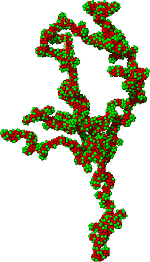 Science@NASA Home |
Interstellar Dust in the WindNASA's STARDUST probe is collecting samples of a cloud of gas and dust that is moving through our solar system from interstellar space. |
 Science@NASA Home |
Interstellar Dust in the WindNASA's STARDUST probe is collecting samples of a cloud of gas and dust that is moving through our solar system from interstellar space. |
|
 Right now, Stardust is oriented so that the interstellar dust
particles are hitting the backside of the collector. This collection
began on February 22, when the spacecraft's sample return capsule
opened and the aerogel collector was moved out of the capsule.
It will remain in this configuration until May 1, when the collector
will return to its stowed position for safe storage until mid-2002,
when another period of interstellar dust collection is scheduled.
Right now, Stardust is oriented so that the interstellar dust
particles are hitting the backside of the collector. This collection
began on February 22, when the spacecraft's sample return capsule
opened and the aerogel collector was moved out of the capsule.
It will remain in this configuration until May 1, when the collector
will return to its stowed position for safe storage until mid-2002,
when another period of interstellar dust collection is scheduled.
Right: Nobody really knows what a typical interstellar dust grain looks like. By studying how dust absorbs, emits, and reflects light, astronomers do know that interstellar dust is much different than the cell and lint based dust found around a typical house. Recent work indicates that most dust grains are not spherical. The above picture shows the result of a fractal adhesion model for dust grains involving random conglomerates of spherical compounds of different properties, here artificially highlighted by different colors. [more information] "The project's name, 'Stardust,' reflects the importance of this event," said Stardust Project Manager Dr. Kenneth Atkins of NASA's Jet Propulsion Laboratory (JPL), Pasadena, Calif. "It's the first time anyone has attempted to catch anything like this and bring it home. After all the design, building, testing, and now the flying of this spacecraft over the past four years, the moment of truth for the collector is here. These tiny particles zip by at 20 to 25 kilometers per second (about 45,000 to 56,000 miles per hour) relative to the spacecraft. The aerogel must slow them to a stop in fractions of an inch."
|
| Web Links |
|
STARDUST
Mission home page
-- from JPL The Science of STARDUST -- from JPL STARDUST Education web page -- from JPL Why comet Wild-2? -- from the JPL STARDUST team Where is comet Wild-2 right now? -- from the JPL STARDUST team, updated every 5 minutes Orbital elements of comet Wild-2 -- from the JPL STARDUST team More about aerogel -- from JPL |
|